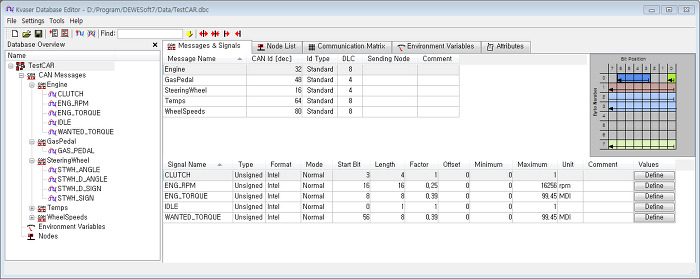Oct 21, 2013 You can put together a simple serial model that would interface with serial to CAN dongle, however to use.dbc files and VNT CAN blocks you need a supported device. Simulink is more than likely overkill for all but the top level guys that are doing real deep CAN bus work, like integrating aftermarket ECU’s into OEM applications. Please click here To view all translated. Load.dbc Files and Create Messages. The database.dbc file contains definitions of CAN messages. Opening DBC files. Did your computer fail to open a DBC file? We explain what DBC files are and recommend software that we know can open or convert your DBC files. CANdbLib is a programming library that lets you use CAN databases in your own tools. The library offers sharing of DBC data with all project partners via the.
We discussed how in-vehicle networks work over CAN. Now we’ll look into the protocol and how it’s used in the automotive industry. The Bus On the hardware side, there’s two types of CAN: differential (or high-speed) and single wire. Differential uses two wires and can operate up to 1 Mbps. Single wire runs on a single wire, and at lower speeds, but is cheaper to implement.
Differential is used in more critical applications, such as engine control, and single wire is used for less important things, such as HVAC and window control. Many controllers can connect to the same bus in a multi-master configuration. All messages are broadcast to every controller on the bus. An oversimplified in-vehicle network The structure of a CAN message From a software perspective CAN message consists of 3 parts: an identifier, a data length code, and up to eight bytes of data.

The identifier (ID) is used to specify what the message means, and who’s sending it. Typically standard IDs are 11 bits, but there are also 29 bit extended type IDs. The ID also defines the priority: the lower the ID, the higher the message’s priority. Internet Tuner 1.2.3870 on this page. The data length code (DLC) is 4 bits, and specifies how many bytes of data will be in the message. In some applications, a DLC of 8 is always used, and unused data bytes are padded with zeros.
Finally, the 8 bytes of data contain the actual information. The meaning of the information is inferred from the message ID, and the length is specified by the DLC.
Decoding & Databases To make sense of the 8 data bytes, the controller will decode the data into signal such as engine RPM, fuel level, or brake pedal position. Each signal has a start bit and end bit, which are used to select the correct bits out of the 8 bytes. No signal information is transmitted over the bus. Instead all controllers must agree on the layout of messages and signals beforehand. Below is the table of signals, and the graphical layout of a sample message. A table of CAN signals that make up a message A sample CAN message layout To help program controllers that agree on messages and signals, a CAN database is used. This database contains definitions of all messages and signals.
The most popular format is DBC, which is a proprietary (but ASCII based) format by Vector. The DBC editing tool,, is free (as in beer). The databases are used to auto-generate code that can interpret the messages.
With a database file in hand, you can easily sniff the CAN bus and interpret all kinds of data. One example is a hack we featured that. You can also pretend to be controllers by sending spoofed data onto the bus. For example, you could send a fake engine RPM to the instrument cluster.
No, this car wasn’t actually doing 8000 RPM. The majority of the communications during normal operation work by decoding a database. However, for diagnostic applications, there are special protocols that are used. Next time, we’ll look at how these protocols work, and what fun can be had with them.
CAN Hacking • • • • Posted in,, Tagged,, Post navigation. There is no “legal chance” to get the DBC files from a car manufactor and the manufactores does not exchange DBCs between each other. There is no standard, because you can make conclusions about the build in sensors or other hardware. It is also not allowed to drive cars with direct CAN access from outside the cars closed system on public streeds, but what you do on private ground depends on you. Only cars with special licenses can drive in public. But If you have CAN access, it is very easy to verify the CAN messages, by switching, pushing or whatever.